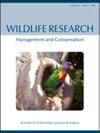Can conditioned taste aversion be deployed at a landscape level to mitigate the impact of invasive cane toads on northern quolls?
IF 1.6
3区 生物学
Q3 ECOLOGY
引用次数: 0
Abstract
ABSTRACT Context. Animals can be taught new behaviours to mitigate threatening processes. However, it is yet to be confirmed if such teaching can be deployed in the field. Here we test this possibility using the invasion of cane toads because they are highly toxic novel prey items to many predators across northern Australia. Aims. Research has shown that training predators to avoid toads, using conditioned taste aversion (CTA), significantly improves the survival rates of individuals. We sought to determine if deployment of CTA baits, in situ, could reduce cane toad impacts on a mammalian predator, the northern quoll (Dasyurus hallucatus). Methods. The work was conducted in the Kimberley, Western Australia, where we treated three quoll populations with training baits from November 2015–November 2017, and kept four populations as controls. We used camera traps and Bayesian hierarchal modelling to estimate the population size of quolls on up to four occasions before, and two occasions after, cane toad arrival. Key results. We observed a 65% reduction in quoll population size at control sites and a 94% reduction at treatment sites: a significant effect of aversion training, but in the direction opposite to that expected. Conclusions. Two complexities – decay of aversion, and individual variation – together, may explain our result. Our trials indicate that most animals are no longer averse within 120 days post-training. Earlier studies indicating that aversion training lasts longer may have inadvertently observed innate (i.e. genetically based) aversion to cane toads. Another possibility is that our dose rate of thiabendazole within the CTA baits was, in fact, too low; or the result may be an artefact of the non-random assignment of treatment and control groups. Ultimately, there is no way of determining exactly why our outcome occurred without further laboratory/captive trails. Regardless, our study demonstrates a failure of CTA training to mitigate the impact of cane toads on northern quolls in this system. Implications. Our result calls into question the value of this approach for conserving quoll populations, at least in its current form. More generally, our results point to the often-unexpected complexities encountered as ideas progress from captive trials to field deployment.是否可以在景观层面部署条件性味觉厌恶,以减轻入侵的甘蔗蟾蜍对北袋鼬的影响?
本文章由计算机程序翻译,如有差异,请以英文原文为准。
求助全文
约1分钟内获得全文
求助全文
来源期刊

Wildlife Research
生物-动物学
CiteScore
4.30
自引率
15.80%
发文量
56
审稿时长
3 months
期刊介绍:
Wildlife Research represents an international forum for the publication of research and debate on the ecology, management and conservation of wild animals in natural and modified habitats. The journal combines basic research in wildlife ecology with advances in science-based management practice. Subject areas include: applied ecology; conservation biology; ecosystem management; management of over-abundant, pest and invasive species; global change and wildlife management; diseases and their impacts on wildlife populations; human dimensions of management and conservation; assessing management outcomes; and the implications of wildlife research for policy development. Readers can expect a range of papers covering well-structured field studies, manipulative experiments, and analytical and modelling studies. All articles aim to improve the practice of wildlife management and contribute conceptual advances to our knowledge and understanding of wildlife ecology.
Wildlife Research is a vital resource for wildlife scientists, students and managers, applied ecologists, conservation biologists, environmental consultants and NGOs and government policy advisors.
Wildlife Research is published with the endorsement of the Commonwealth Scientific and Industrial Research Organisation (CSIRO) and the Australian Academy of Science.
 求助内容:
求助内容: 应助结果提醒方式:
应助结果提醒方式:


